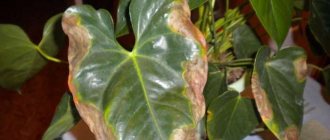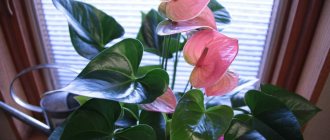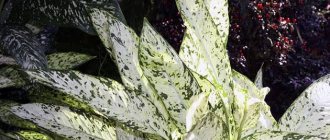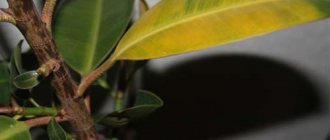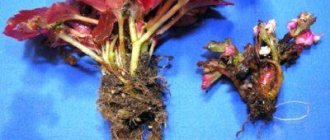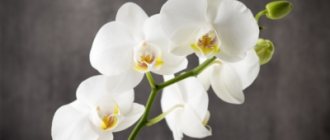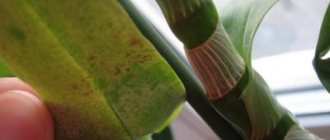Anthurium is an elegant indoor flowering plant that makes a great addition to any room. Another popular name is “male happiness.” Therefore, it is believed that in houses with this type of plant, representatives of the stronger sex will succeed and be happy. Although some people consider this flower to be fussy, it is easy to care for. It is enough to follow simple rules, and he will please the owner with his appearance. However, if you make a mistake in care, the plant will get sick. This can be determined by appearance. The appearance of yellow leaves is the first sign of problems. It is worth finding out how to determine the cause of yellowing and whether you should always worry, and also, if anthurium leaves turn yellow, what to do about it.
The appearance of yellow spots on anthurium: when to worry
The formation of yellow spots does not always indicate a disease or any problem. Sometimes this is a completely natural feature of the plant. If the care is correct, young, healthy, green leaves will appear regularly, and old ones will die off, so yellow leaves often appear on the stem. This is a natural process called aging. These old leaves just need to be removed, sometimes they fall off on their own.
Anthurium andreanum
Important! The number of such sheets is important: no more than 2-3 cases within one year. At the same time, there will definitely be new ones in their place. Otherwise, this is no longer natural aging, but a sign of illness and trouble.
Like other plants, anthurium can be stressed. It is caused by transplantation or moving to another location. Thanks to quality care, flowers can quickly return to their normal state and grow healthy. However, if the entire anthurium is covered with yellow spots, the leaves dry out, you need to find the cause of this condition and take measures to eliminate it, otherwise the flower will die.
Yellowed leaves on an anthurium
Often the cause of flower stress is precisely insufficient care. It can cause irreparable damage to plants. Therefore, it is important to quickly determine the cause of the problem. Plants of this species can also be infected by pests.
Incorrect lighting
The health of anthurium is greatly influenced by its habitat. This tropical plant naturally occurs in partial shade.
Direct sunlight burns sensitive leaves. Lack of light also has a negative impact.
Slow growth, infrequent and infrequent flowering, and yellow spots are all signs of insufficient light. Species with dense, dark green leaves are especially vulnerable. Short daylight hours or constant exposure to shade cause the petioles to lengthen. The leaves themselves turn pale and decrease in size. To improve the health of your flower and stop the development of yellow spots, place it in a brighter location.
It is important not to burn the leaves from sunlight, as excessive light will also cause yellow and brown spots. A possible solution to this problem is to stick a special film on the window glass that reflects daylight. If darkening is not possible, the pot should be placed in partial shade or covered in any type of screen with high light activity.
Why do anthurium leaves turn yellow?
The main reasons include: choosing the wrong pot, low humidity, excessive watering, too low or high room temperature. All of this could be the source of the problem. It is recommended to analyze and check each reason.
Location and influence of low temperature
Why anthurium does not bloom at home and what to do
The room should always be warm. If the room is less than +15 degrees or there are drafts, the flowers will suffer. Except for the yellow color, the leaves become too soft and limp.
Yellowness appears at the edges and gradually moves towards the middle of the plate. Then the leaves dry out and turn black. When the central heating system is switched off, a similar problem often occurs.
Diseases and pests
Pests often cause external changes in plants. They can also affect the root system, which poses a great threat to the life of anthurium. Leaves may turn yellow due to the following diseases:
- Gray rot. This disease can be caused by excessive indoor humidity. It all starts with a yellow coating, then it gradually turns white. It is important to detect the disease at an early stage so that flowers can be treated effectively and damage to them can be reduced.
- Septoria is caused by fungal infections. The spots on the plate grow quickly and spread over a large area. The leaf begins to fade.
- Anthracosis is associated with improper care during cultivation. The leaf becomes white, and only its tip turns yellow.
- Chlorosis occurs due to a lack of nutrients in the soil, such as magnesium or iron. The plant looks very dry, the dividing veins are not visible on the plate.
- Root rot is characterized by rapid development: leaves fall off in a few days due to the cessation of nutrient supply.
Important! To understand whether a pest is related to the health of the anthurium, it is necessary to carefully check each leaf at close range.
Plant pests
Yellowing after transplantation
Yellowing of leaves after transplantation occurs quite often. Errors in this process can deteriorate the condition of the flowers. If there are signs of yellowing after replanting, this means that the root system may be damaged. Due to its sensitivity, it is necessary to plant plants in the soil as carefully as possible. Complete replacement of soil with new soil is carried out only in severe cases.
Important! If flowers are bought in a store, all soil must be completely replaced. Then the anthurium should not be watered for the first 3 days to prevent the formation of rot.
Incorrect watering mode
Excessive humidity can cause leaves to turn yellow. Certain measures must be taken to eliminate excess moisture. The cause of rotting and yellowing may be:
- Too much water.
- Wrong choice of substrate.
- Using pots that are too large and making mistakes in choosing a drainage layer, which also causes stress to the plants.
Moreover, the danger lies not only in using too much water, but also not enough. Excessive dryness can also cause root rot. Yellowing begins at the edges of the leaves and moves toward the middle.
Planting in the wrong pot
If the chosen flower pot does not have room for roots to grow and develop, the plant will not grow and exist normally. Regular containers are not allowed for growing this plant. Only special flower pots are suitable for anthurium so that it can fully accommodate its roots. Otherwise the flower will slowly die.
Suitable pots for the plant
Lighting violation
The plant loves a lot of light. It can be in the twilight, but it does not feel very comfortable. Therefore, it is necessary to provide it with sufficient lighting. At the same time, bright direct light (especially sunlight passing through glass) can negatively affect growth and cause overheating.
Accordingly, yellowness may occur due to burns caused by exposure to sunlight. You can glue a special sun protection layer to the glass to solve this problem.
Important! Good light in sufficient quantities can be obtained with artificial lighting. But you don't need to install it next to flowers. The room just needs to be bright enough.
Lack of fertilizing and fertilizers
It is important not only to choose the right fertilizer to provide plants with enough additional food and vitamins, but also to use reasonable time intervals.
The active growing season of anthurium lasts from April to August, that is, most of the summer and spring. If you do not fertilize at this moment, the leaves will become covered with a yellow coating and will fall off over time.
Important! Over-fertilization is also dangerous, so all included instructions must be strictly followed.
Non-communicable diseases
Chlorosis
If yellow spots are visible on green foliage in bright light, the crop suffers from poor nutrition (lack of magnesium and iron)
It is important to take care of regularly feeding the plant with fertilizers for decorative flowers.
Smallpox
Yellow-green bumps and ring-shaped yellowing are a consequence of low temperature combined with high humidity. If you forget about regularly feeding the anthurium, the plant will not have the strength to resist smallpox, and it will take a long time to revive the culture.
Enatsii
When a flower is infected with enation, uneven curvature of the leaves, an ugly and humpbacked appearance are visible, and the anthurium may turn black. The disease progresses in cold rooms with drafts and sudden changes in dry and humid air.
How to cure anthurium
Anthurium - home care: why leaves dry
Procedure if yellowing is detected:
- It is recommended to remove leaves that have turned yellow. This will help the plant recover faster.
- If the cause of deterioration is improper care, the situation must be improved. To do this, you need to install an air humidifier and strictly follow the watering and fertilizing plan.
- The flower must be replanted in strict accordance with all the rules, using only pots of the correct shape and size.
- If rot is the source of the problem, you need to remove the flowers from the pot, rinse the roots with warm water and carefully inspect them. Plants can be preserved by placing them in a disinfectant solution for 20 minutes. After this, the roots need to be dried, the plant should be transplanted into a new container and watered, wait until new leaves begin to grow.
Lighting is important for anthurium
Possible causes of yellowness
The most common reason is that when watering, water drips onto the crown, and yellow spots (burns) appear on it. Try to spray the plant early in the morning or after sunset. Other most common problems:
Violation of light conditions and temperature
Almost half of the grown anthurium species are epiphytes. They require bright light, warm and humid conditions. Tolerates relative partial shade. It needs shade from the sun's rays. Experienced gardeners store the flower on windowsills that face the east and north-west sides.
Drafts in the room are not allowed. The optimal temperature is 20−28 °C, not lower than 18 °C. In autumn and winter, the bush needs cool air of 15−16 °C. Only the Scherzer variety requires 12−15 °C in the cold period. In order for the anthurium to bloom early, in mid-January the air temperature rises to 25 °C.
Improper watering
The quantity, volume and quality of moisture play a paramount role. You should not moisten the flower with running water collected from the tap before watering. The liquid is softened with lemon juice or vinegar. The added sourness should not be felt. Rainwater without chlorine and lime is ideal. Temperature - from 20 to 24 degrees above 0.
The frequency of watering depends on the drying of the soil. If the topsoil is dry, mist the plant. Do not allow water to stagnate, as this will cause the roots to dry out. Yellowness appears on the leaves - this is rot. If you don't hurry, the plant will die. To prevent the development of the disease, you need to urgently replant the indoor flower, rinse the roots thoroughly and remove the damaged parts. Treat the cuts with activated charcoal or charcoal.
The flower pot must accommodate the plant's root system. Drainage of at least 30% of the filler volume so that water stagnates in the container. River or sea pebbles, fragments of pottery, and expanded clay are suitable for it.
Feeding in spring and summer is carried out 1-2 times a month. Anthurium easily tolerates fertilizers for ornamental and flowering bushes. The vitamin mixture is diluted by half the recommended dosage.
The soil where anthurium grows should be loose and ventilated. If you don’t want to invent a combination of mixtures, you can purchase ready-made universal soil with the addition of bark.
Flower diseases
Like other plants, pests do not spare this beauty. The general condition of the anthurium has worsened and the leaves have turned yellow; experienced gardeners can explain what to do with such signs of the disease. First, external discomfort is excluded: lack of light and heat, low room temperature, draft. If this does not help, there is a parasite on the bushes.
Why do leaves turn yellow after transplanting?
During the period of annual planting, a third of the roots are damaged, and even small cracks can ruin the plant. The crown of the “male pet” turns yellow and dries. You can replant a flower using the transshipment method, thereby minimizing the risk.
The growth stimulator helps the fragile bush to quickly recover. 7 days after replanting the anthurium, moisten the bush with Epin.
Popular articles Ivy geranium: care at home
If jaundice has formed along the edges of the leaves, this indicates rotting of the root system. Therefore, the bush is watered abundantly. The disease is treated by replanting the flower and removing all damaged roots.
Carefully monitor the top layer of soil, only when it is completely dry, then water it. In winter, the bush is watered once every 10 days, otherwise a fungal disease will appear due to the low temperature background.
Preventive measures
The lower leaves of phlox turn yellow: what to do
One of the main precautions is to regularly check for diseases and insect pests on anthurium. This will allow you to detect the first signs of a problem in time. It is also recommended to carefully follow the care instructions.
It is important to create the best and most suitable conditions for a comfortable life for plants. If traces of the disease are found on the surface, it is necessary to isolate the plant from other flowers to prevent spread. Compliance with precautionary measures will prevent the deterioration of the anthurium’s condition, allow you to quickly detect troubles and heal the flowers.
Yellowing of anthurium leaves can be caused not only by disease or improper care, but also by natural processes inside the flower. If this problem is discovered, you need to find the true cause, and then act immediately, do everything possible to save your house plants.
Control and prevention measures
Most problems with growing anthurium are caused by violation of the rules of care. If you create conditions suitable for the plant, follow the watering and fertilizing regimes, and regularly inspect the flower, it will grow and develop well. The best prevention of any disease is compliance with the plant maintenance requirements:
- Comfortable temperature is 18–25 ℃; the flower does not tolerate sudden changes and is afraid of cold drafts.
- Maintain air humidity at 70–80%. If it is not possible to use a humidifier and there is no aquarium to place the flower next to it, you need to spray the leaves (not the flowers!) with settled warm water.
- Intense but diffuse lighting. The best option is to place the anthurium on a western or eastern window sill, and in winter add additional light for several hours.
- Fertilizers are applied only during the growing season. Use purchased complex mixtures, diluting them 4 times stronger than indicated in the instructions.
- You need to regularly inspect the flower, monitor the brightness of the color, check whether it stops growing, and whether the angle of inclination of the leaves decreases. This will help you notice the deterioration of the anthurium’s condition in time and take the necessary measures.
Popular articles Sticky drops on orchid leaves: causes and treatment methods
If rot is noticed on the roots, an urgent transplant into new soil is needed:
- the pot is replaced with a new one or thoroughly washed and treated with boiling water;
- the affected roots are cut off, the sections are sprinkled with crushed tablets of activated carbon.
If a small part of the root system is affected, there is a high chance that the flower will recover after being sick after the “treatment”. But if many roots are removed, the anthurium has little chance of recovery.
If you follow these requirements, you can avoid the causes of yellowing of plant foliage. And having noticed a problem, analyze it and take timely measures to improve the health of the beautiful flower “male happiness”.
Many gardeners consider anthurium to be a capricious plant; for its successful growth and development, as well as for lush flowering, you will have to create a piece of the South American tropics in your apartment. If the conditions are not met, the anthurium may become ill or be attacked by pests.
Photo
In the photo you can see what the yellow spots on the leaves of Male Happiness look like:
This is a photo of a plant whose leaf tips are drying:
